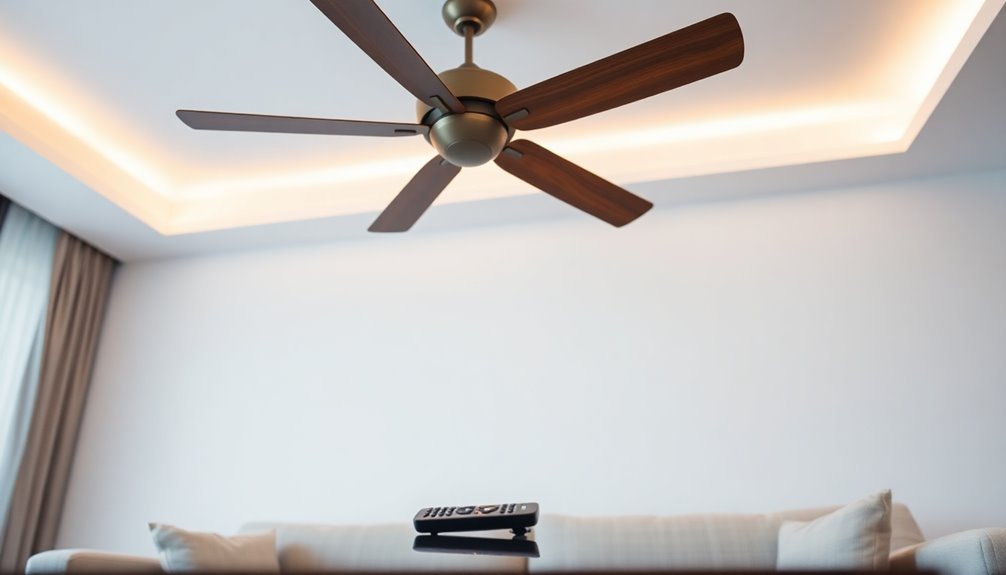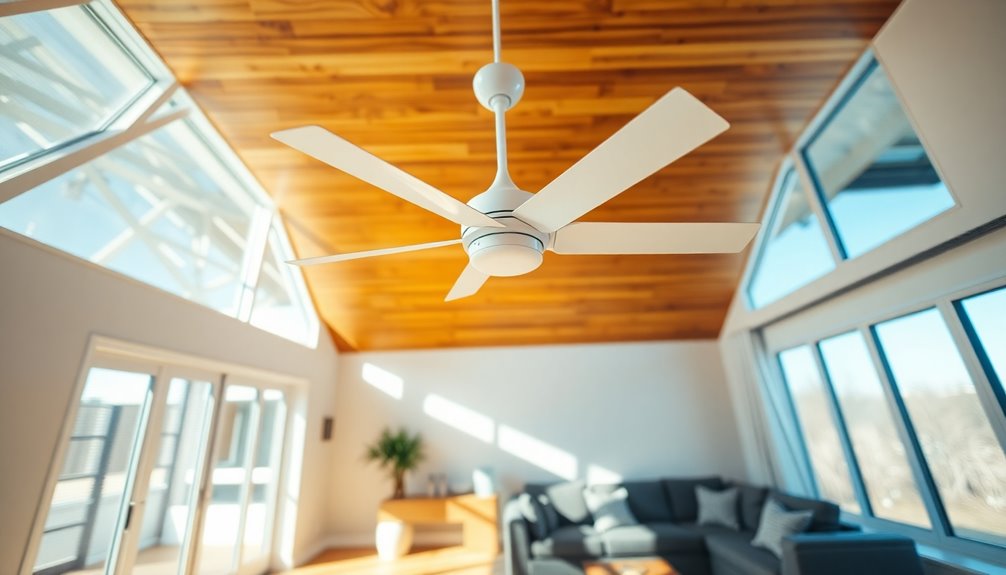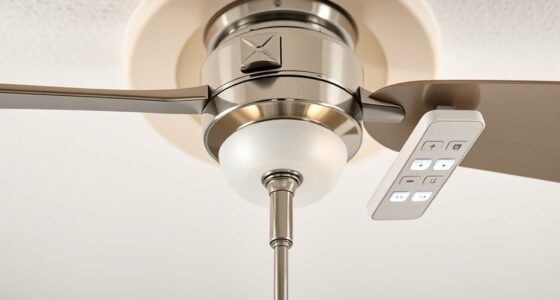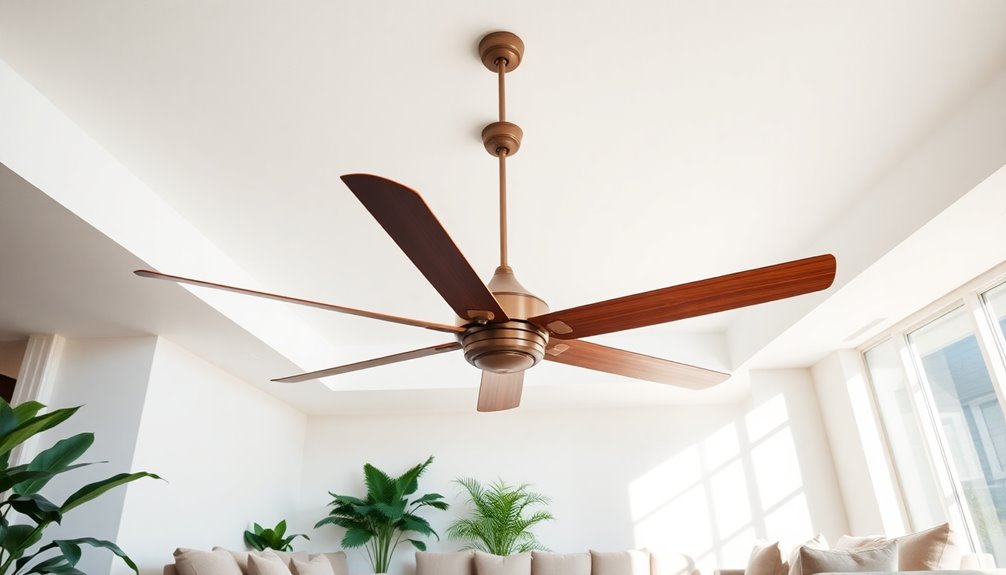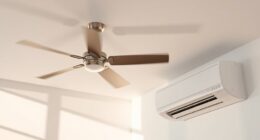Yes, you can use a wall switch with a remote control ceiling fan, but it depends on compatibility and your fan's specific features. Many fans allow both controls to function, but some may not operate simultaneously, leading to potential frustration. Remember to check wiring requirements before installation, as some setups may need a neutral wire. Avoid using dimmer switches for fans, as they can cause operational issues. If you're experiencing problems, troubleshooting steps can help improve functionality. Want to uncover more tips and insights on optimizing your fan's performance?
Key Takeaways
- Many remote control ceiling fans can be operated with a wall switch, but functionality may vary by model and manufacturer.
- Some fans allow the wall switch to control the light even when the fan is off, enhancing usability.
- It's important to check compatibility between the wall switch and remote control to avoid operational conflicts.
- Power outages may render wall switches ineffective, requiring reactivation of the fan via the remote control.
- Using standard on-off switches is recommended, as dimmers can interfere with fan operation.
Understanding Control Mechanisms

Understanding control mechanisms for ceiling fans can greatly enhance your experience. When you use a remote control for your ceiling fan, you typically have the option to control it via the remote or a wall switch. However, some fans allow for both to operate simultaneously, offering flexibility.
It's important to know that when power is restored after an outage, the default settings of remote receivers often disable the wall switch, requiring you to use the remote to turn the fan or light back on.
Additionally, some remote-controlled fans default to the light being on and the fan off after a power interruption, which can complicate your experience.
If you're considering mixing control protocols, like using smart switches with your remote-controlled fan, be aware that compatibility issues may arise, making it generally unfeasible.
To make the most of your ceiling fan's control features, always refer to the manufacturer's instructions for the remote receiver. This knowledge is vital for effective control and guarantees you can enjoy all the functionalities your ceiling fan offers without frustration.
Installation Requirements

When setting up a wall switch for your remote control ceiling fan, you need to confirm that your existing wiring meets the fan's requirements. This includes verifying proper connections for live, neutral, and ground wires.
Here are some key installation requirements to keep in mind:
- Neutral Wire: Some systems, like Lutron Caseta, require a neutral wire at the switch box, while others, like Hunter wireless control systems, don't.
- Standard Switch: Opt for a standard on-off switch rather than a dimmer. Dimmers can interfere with the fan's operation by reducing power flow.
- Professional Help: If your setup looks complex or if you need to modify existing wiring, consider hiring a professional. This confirms safety and functionality.
It's also essential to understand that many remote receivers default to off mode when power is restored. This means you'll need to use the remote to turn on the fan after flipping the wall switch.
Functionality of Controls

When you use a wall switch with a remote control ceiling fan, understanding how the controls work together is essential.
Many fans default to off when power is restored, which can make using the wall switch tricky.
Plus, compatibility between the remote and wall switch is key to avoiding user experience challenges, so be sure to choose the right components.
Control Mechanism Compatibility
Ceiling fan control mechanisms can vary considerably, making it vital to know how remote controls and wall switches interact.
If you're considering using a wall switch with your remote control ceiling fan, here are three key points to keep in mind:
- Simultaneous Use: Most ceiling fans with remote controls don't support the simultaneous use of both the remote and wall switch. This can lead to confusion and functionality conflicts.
- Default Settings: After a power outage, some fans may not respond to wall switches due to their default settings. In such cases, you'll need the remote to turn the fan or light back on.
- Model Variability: Certain fan models allow the wall switch to control the light even when the fan is turned off. This indicates that compatibility can vary notably based on the specific model.
Understanding these aspects of compatibility is important.
If you mix different control types, like smart switches with remote-controlled fans, you could run into operational issues.
Always check wiring and compatibility to guarantee smooth functionality!
Remote Receiver Behavior
Understanding how the remote receiver behaves is essential for effectively managing your ceiling fan and its lighting. Most remote-controlled ceiling fans default to "off" mode when power is restored. This means if you use the wall switch to turn the fan off, you'll need the remote to turn it back on.
The interaction between the wall switch and the remote can create conflicts. For instance, turning the fan off at the wall switch may disable the remote receiver, rendering your remote useless until the switch is turned back on.
However, some remote receivers allow for light control via the wall switch even when the fan is off. This variation in receiver behavior means that understanding your specific ceiling fan model is significant.
Many users find that controlling the light through the wall switch often leads to a smoother experience, as certain fan models perform better this way. By familiarizing yourself with your remote receiver's functionality, you can avoid frustration and maintain consistent control over both the fan and lighting, making your setup more efficient and user-friendly.
User Experience Challenges
User experience with remote control ceiling fans often suffers due to conflicting functionalities between the remote and wall switch.
Many ceiling fans don't support simultaneous use of both controls, which can lead to frustration. You might find yourself trying to adjust the fan from different locations, only to discover that the wall switch has rendered the remote ineffective.
Here are three common challenges you may face:
- Power Outages: After an outage, the fan often defaults to off mode. You'll need the remote to turn it back on, which can be inconvenient, especially in the dark.
- Wall Switch Control: If you turn off the fan using the wall switch, you'll likely find the remote won't work until the switch is turned back on, complicating your control process.
- Limited Functionality: Some fan models allow limited wall switch functions even when off, but this varies widely by manufacturer, leading to confusion about what you can or can't do.
Choosing the right ceiling fan model can enhance your experience, as user feedback highlights issues like poor dimming and noise levels that can further complicate control.
Common Compatibility Issues

When using a wall switch with your remote control ceiling fan, you might run into compatibility issues between different manufacturers.
It's crucial to verify your fan and control system are designed to work together, as signal interference can disrupt functionality.
Keep an eye out for these problems to avoid frustration during operation.
Manufacturer Compatibility Concerns
While many ceiling fans with remote controls offer convenience, they often come with manufacturer compatibility concerns that can complicate their use with wall switches.
Here are some common issues you might face:
- Remote-Only Operation: Many ceiling fans are designed to operate primarily with the remote. Once you power off the fan using the remote, the wall switch may become ineffective, leaving you reliant on the remote for operation.
- Mixed Brand Problems: Compatibility issues can arise when you mix different fan brands and control systems. Some manufacturers don't allow simultaneous use of remote and wall switch controls, complicating your setup.
- Dimming Interference: If your wall switch has dimmer capabilities, it can interfere with the fan's performance. Users often find that standard on-off switches work much better with remote-controlled ceiling fans.
Understanding these manufacturer compatibility concerns can help you make informed decisions about how to integrate your ceiling fan with wall switches effectively.
Before you set up your fan, it's wise to check the specific compatibility requirements from the manufacturer to avoid potential headaches later on.
Remote Signal Interference Issues**
Even with compatibility concerns addressed, remote signal interference can still disrupt the seamless operation of your ceiling fan. Overlapping frequencies from other wireless devices can lead to a frustrating loss of control.
If you've placed your fan far from the remote, obstacles like walls and furniture can weaken the signal, making it tough to operate the fan from a distance.
Moreover, having multiple remote-controlled devices in one area can create signal confusion, resulting in your fan responding unexpectedly. You might find it turning on or off without your command due to this interference.
Regularly checking the battery in your remote is essential, as depletion can greatly disrupt the signal.
Additionally, some ceiling fan models come with default settings that prioritize remote control, which means the wall switch may not work until you've used the remote to power it on first.
To guarantee smooth operation, be aware of your environment and consider relocating any devices that might interfere with the remote signal. By taking these steps, you can enjoy your ceiling fan without the hassle of remote signal issues.
Troubleshooting Tips

Troubleshooting a remote control ceiling fan can feel frustrating, but a few simple steps can help you get it back in working order. If your fan isn't responding, try these tips to regain fan control:
- Check the Wall Switch: Verify the wall switch is turned on. If it's off, it may disable the remote control functionality, meaning you'll need to use the remote to turn the fan back on.
- Inspect the Remote Batteries: Weak batteries can lead to a loss of signal. Replace the batteries in your remote control to confirm it communicates effectively with the fan.
- Reset the Receiver: If the fan still won't respond, disconnect and reconnect the remote receiver. This can help establish proper communication between the remote and the ceiling fan.
Additionally, make certain all wiring connections are secure and correctly matched according to color codes.
If you're using a wall dimmer switch, consider replacing it with a standard on-off switch, as dimmers can interfere with fan performance.
Following these troubleshooting tips should help you get your remote control ceiling fan working smoothly again.
User Experience Insights

Understanding user experiences with remote control ceiling fans can help clarify common frustrations and operational challenges. Many users find that their ceiling fans typically don't allow simultaneous control using both a remote and a wall switch, leading to confusion about which method to use. This inconsistency varies widely among different manufacturers and models. Some fans might support both controls, but others may not, which can leave you feeling stuck.
Another common issue arises when power is restored after an outage; the remote receiver's default settings often render your wall switch ineffective. This means you'll have to rely solely on the remote control ceiling fan to operate your fan, which can be frustrating if you prefer using a wall switch.
Users have also reported specific problems with fan models, like Harbor Breeze, especially when using dimmers instead of standard switches. The integration in these cases often falls short.
Community feedback emphasizes the importance of understanding how remote receivers work with wall switches to prevent these operational conflicts. Being aware of these nuances can greatly enhance your user experience with remote control ceiling fans.
Alternative Control Solutions

If you're looking for ways to enhance your control over a remote control ceiling fan, alternative solutions can greatly improve your experience. Wall-mounted options can provide easier access, making them especially beneficial for those with mobility challenges.
Here are some alternatives you might consider:
- Wall-Mounted Remote Controls: These devices can replace handheld remotes, giving you convenient access to your fan settings right from the wall.
- Lutron Dimmer and Fan Control Switches: With these switches, you can adjust both fan speed and light brightness, maximizing your ceiling fan's functionality without needing multiple controls.
- Universal Remote Controls: These handy gadgets allow you to manage multiple ceiling fans and lights from one remote, streamlining your user experience.
When integrating these alternative controls with your existing wall switch, verify compatibility with your wiring to avoid any operational conflicts.
Safety Considerations

Before diving into the installation of a wall switch for your remote control ceiling fan, it's important to take safety seriously. Always turn off the power at the breaker before starting any installation or repairs. This simple step can help you avoid the risk of electrical shock.
After that, grab a non-contact voltage tester to confirm that there's no voltage present in the wires you'll be handling.
Keep in mind that when you use a wall switch to control your ceiling fan, it may override the remote control functionality. This could lead to some confusion, especially if you're switching between the two controls.
Proper grounding is vital when connecting the wall switch, as it minimizes the risk of electrocution and guarantees your installation is safe. Additionally, be aware that improper installation may lead to mechanical failure or other issues, which can compromise safety.
Finally, always follow electrical codes and guidelines during your installation. These rules aren't just recommendations; they're in place to safeguard you and your home.
Maintenance and Care
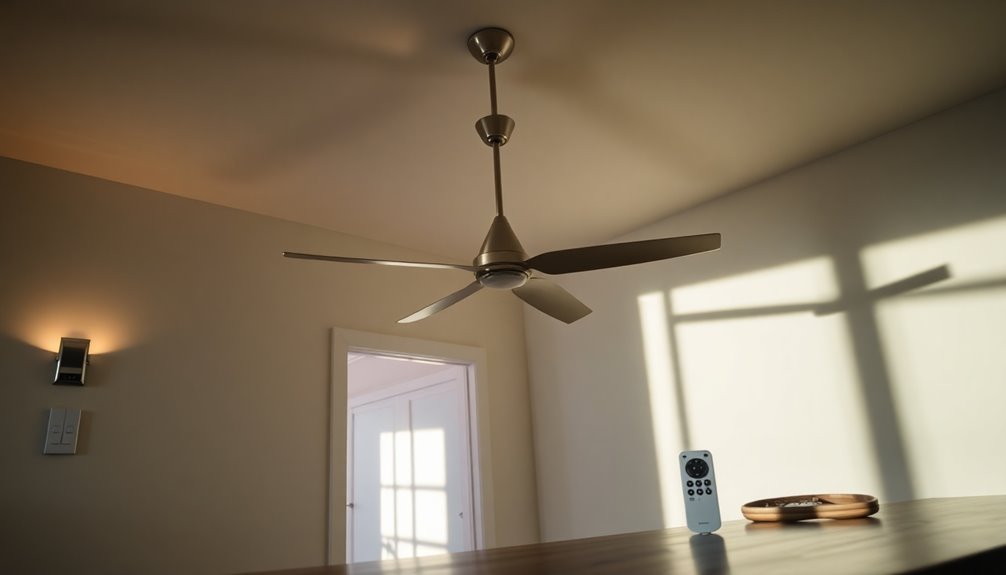
Maintaining your remote control ceiling fan is essential for guaranteeing its longevity and performance. Regular upkeep helps prevent issues, especially if you're using a wall switch to control it. Here are some key maintenance tips to keep your fan running smoothly:
- Check the Batteries: Regularly check and replace the batteries in your remote control. This keeps the remote features functioning consistently.
- Clean the Blades: Dust and clean the fan blades and remote receiver periodically. This prevents buildup, which can affect performance and airflow.
- Inspect Wiring: Periodically inspect the wiring connections at the ceiling and within the fan assembly. Make sure they're secure and free from corrosion to avoid electrical issues.
If your remote control becomes unresponsive, try resetting both the remote and the fan's receiver. This often resolves common connectivity problems.
Also, keep your ceiling fan's remote control away from other wireless devices to minimize interference that could disrupt its signal.
Frequently Asked Questions
Can You Have a Wall Switch and a Remote for a Ceiling Fan?
Yes, you can have both a wall switch and a remote for your ceiling fan, but it depends on the model.
Some fans allow you to use both simultaneously, while others may restrict you to one control method.
Make sure to check the compatibility between your wall switch and the fan's remote control system.
If you wire it incorrectly or use a dimmer switch, you might run into functionality issues.
What Are the Disadvantages of Remote Control Ceiling Fans?
Remote control ceiling fans have some disadvantages you need to take into account.
You might find yourself dependent on the remote, which can be frustrating if the signal drops or if you misplace it.
Additionally, many models aren't compatible with wall dimmer switches, leading to performance issues.
You'll also notice they often reset to off after a power outage, requiring you to use the remote again, which can be inconvenient in your daily routine.
Why Is My Ceiling Fan Not Working With the Wall Switch?
If your ceiling fan's as stubborn as a mule, it mightn't respond to the wall switch.
First, check if the fan was turned off via the remote; it often defaults to off when power's restored. If that's the case, the wall switch won't control it.
Also, make sure the remote's batteries aren't low, and avoid using dimmer switches, which can throw a wrench in the fan's operation.
Can You Use a Remote Ceiling Fan Without a Remote?
You can use a remote ceiling fan without a remote, but your options may be limited.
If the fan has a pull chain or a wall switch, you can still control it that way. However, many remote-controlled fans rely heavily on the remote for most functions.
If you've lost the remote, check if your fan allows basic operation or default settings when power is restored through the wall switch.
Conclusion
To sum up, you can seamlessly sync a wall switch with your remote control ceiling fan for a fabulously flexible experience. By blending both control methods, you gain the power to personalize your comfort with ease. Just be mindful of compatibility and care, ensuring a harmonious haven in your home. So, whether it's a breezy evening or a balmy day, enjoy the delightful dance of air and ambiance as you effortlessly elevate your environment.
